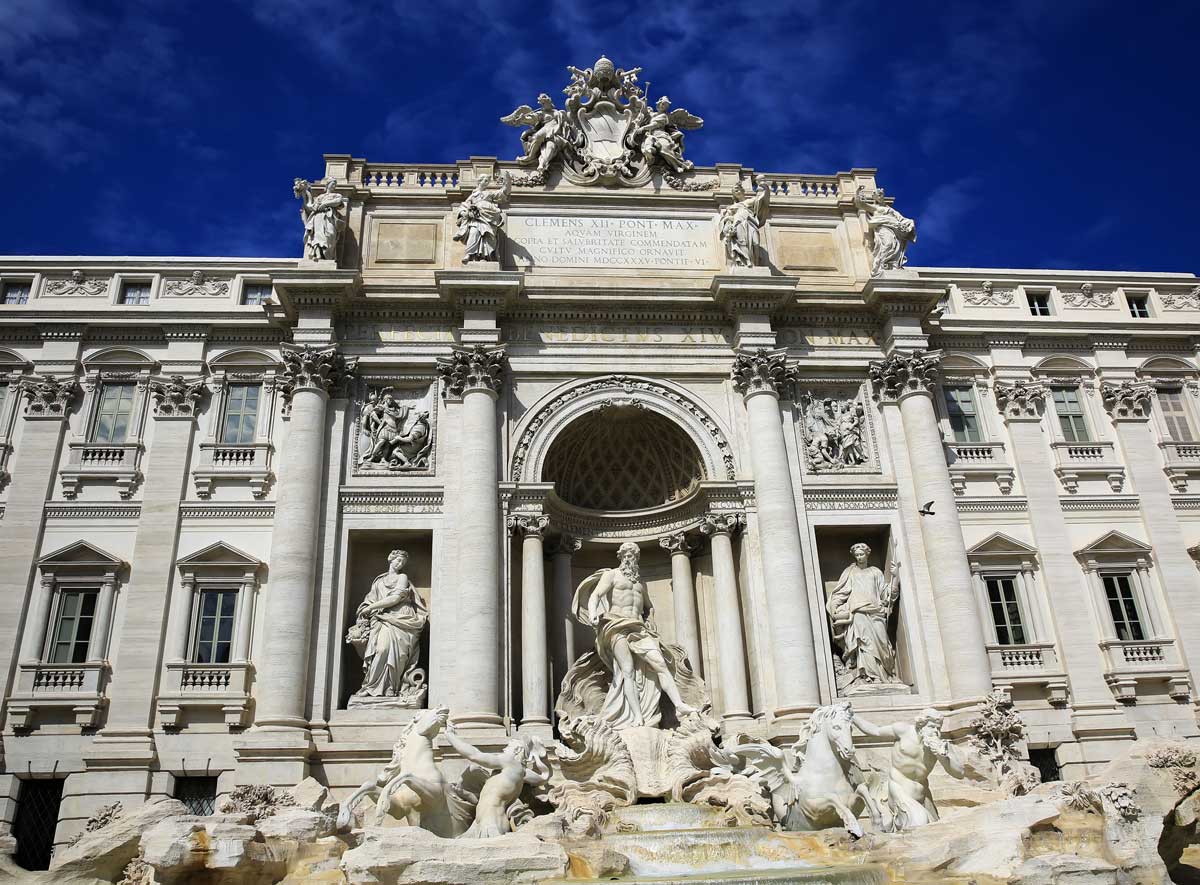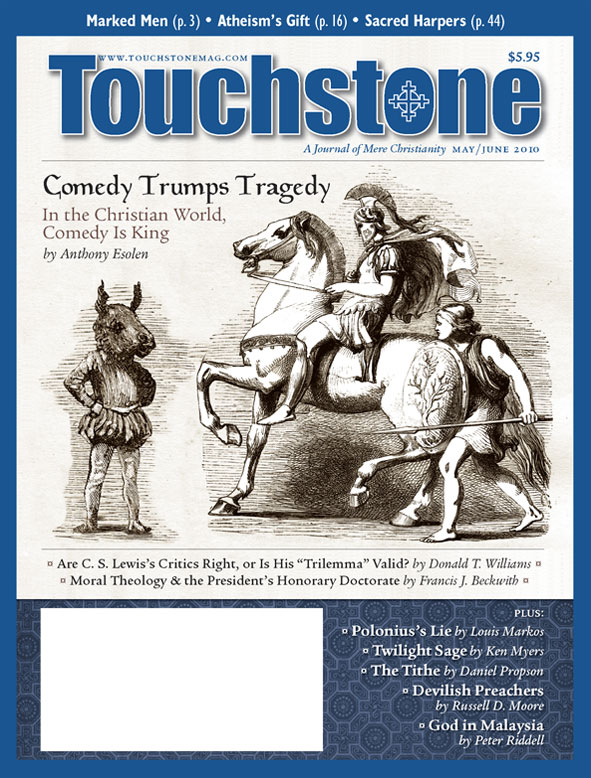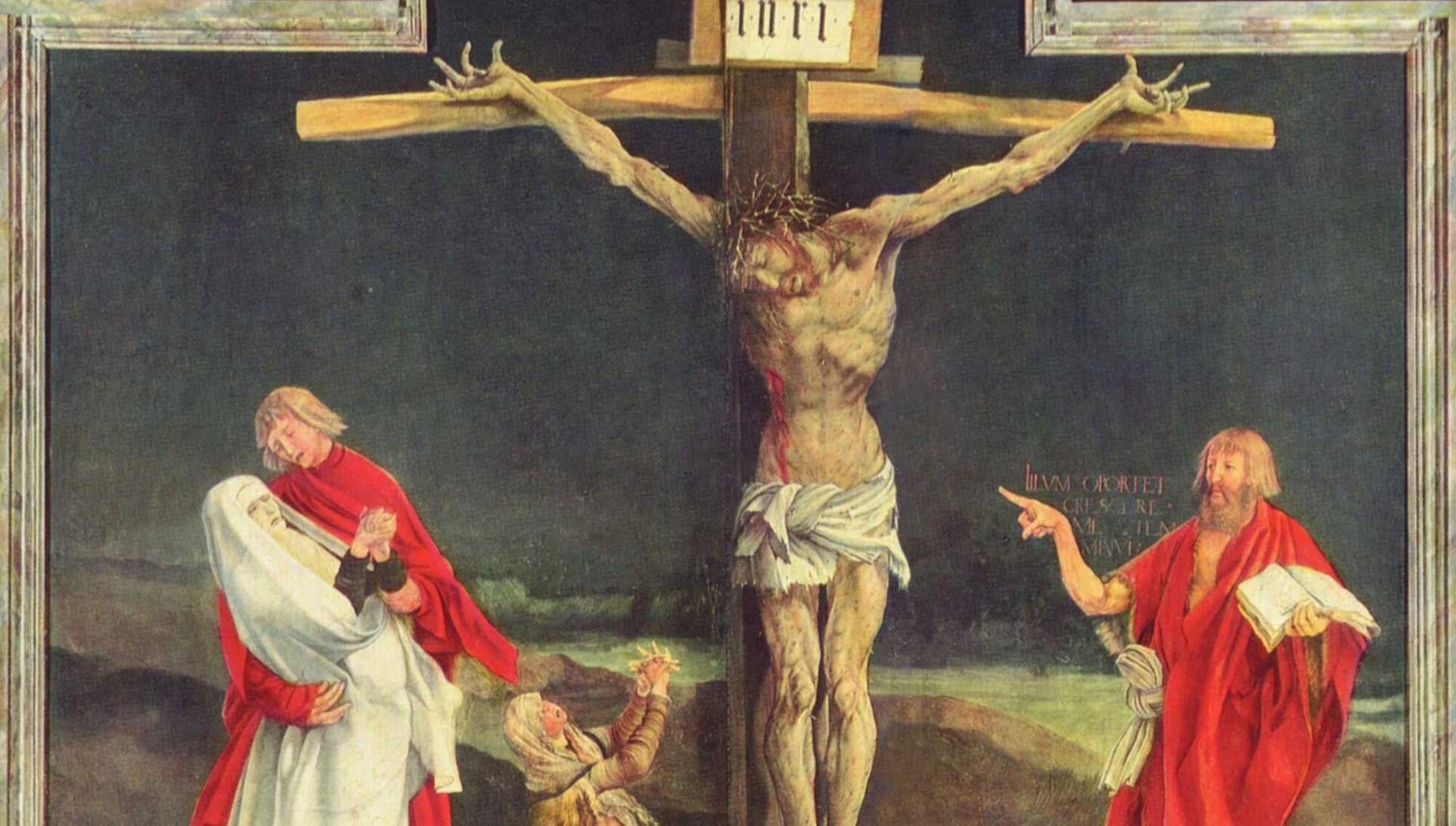Notes from the Other World
The Culture & Transcendence of Sacred Harp Singing
by Philip E. Devine
We gather in a seldom-used Union Chapel in Midcoast Maine. My wife and I are a bit late, and we hear the singing from a half a mile down the road—Sacred Harp (also called “shape note”) singings always begin promptly. After depositing our contribution to the potluck in the community center next door, we enter the chapel and take our places around a square, Celia as a treble, I as a bass. There are also tenors, also called the “leads,” and altos; the leads carry the melody.
In the center stands a woman—or sometimes a man—leading and keeping time. Then the chair announces, “Robert Smith next, followed by Jane Jones.” Robert moves to the center, while calling out “49 bottom,” and the singing continues. Each of us holds on our laps the Bible of the shape note movement, The Sacred Harp, 1991 revision . First, a designated person establishes a convenient pitch—which need not be close to the conventional reading of the notes—then we sing.
As David van Biema describes it in “Give Me That Old-Time Singing,” ( Time, January 17, 2008):
Nothing is weirder than Sacred Harp. Its favored subject matter—the pilgrim, the grave, Christ’s blood—is stark; its style—severe fourths and otherworldly open fifths—has been obsolete for more than a century. Its notation, in which triangles, circles and squares indicate pitch, looks like cuneiform. Yet it exudes power and integrity. Five people sound like a choir; a dozen like a hundred. It is one of the most democratic choral forms: no audience, no permanent conductor—just people addressing one another and God.
Sacred Harp music is sung a capella; the “sacred harp” is the human voice. The music gets its other name— shape note—from the fact that the notes are not all in the conventional shape. The shapes, developed as an aid to sight reading, correspond to a set of syllables somewhat different from the standard sequence do, re, mi. A triangle is fa, an oval is sol, a square is la, and a diamond is mi. Another name for shape note music, favored on websites, is Fasola. We sing these shapes first before launching on the words.
If we take a further look at 49 bottom, we discover that the title, “Mear,” is followed by a metric designation (C.M. = Common Meter). If you consult the “Rudiments of Music” at the beginning of the book, you find that this means “iambic, 8, 6, 8, 6,” where the numbers refer to the number of syllables in a line. It is common, though by no means universal, for the title of a shape note song to tell us nothing of its content; it often refers to the place where the song was composed.
Next, there is a verse of Scripture (in this case Romans 9:22), connected, tightly or loosely, to the theme of the song. Here the text speaks of God’s wrath and our endurance “with much long-suffering.” Next are the author and composer, with dates. The author of 49 bottom is (as is often the case) Isaac Watts (Charles Wesley is another favorite); the tune is anonymous. The dates of both words and music are eighteenth century, but there are texts as early as 1600 (“Long Sought Home,” 235 bottom) and tunes as late as 1989 (“A Thankful Heart,” 475).
Folk Music & Texts
Because the author of Sacred Harp texts is usually known, purists refuse to admit Sacred Harp to the canon of folk music. (Some people believe that Sir Walter Scott wrote the grim Scottish version of the Border Ballad “The Twa Corbies.” Would its ongoing status as a folk song depend on the outcome of this controversy?)
My own preferred definition of a folk song is a bit of popular music that has lasted beyond the nostalgia-driven market for “golden oldies.” By this standard, the Beatles do not quite make it; but shape note does.
Like standard folk music, and like hymns, shape note texts have undergone the “folk process” of modification by successive generations—sometimes to their benefit, sometimes not. So far, pressure to censor the lyrics of Sacred Harp tunes for political correctness has been successfully resisted.
The words are dispersed between the lines of music for the different voices—as if the treble sang verses one and two, the altos three and four, the leads five, and the basses nothing. In fact, each group sings all verses, often repeating part of the last verse. Usually, the group sings only selected stanzas, sometimes omitting even the first. The leader chooses which verses to sing.
Here is the complete text of “Mear”:
Will God forever cast us off?
His wrath forever smoke
Against the people of his love,
His little chosen flock?Think of the tribes so dearly bought
With the Redeemer’s blood
Nor let thy Zion be forgot,
Where once thy glory stood.Where once Thy churches prayed and sang
Thy foes profanely rage;
Amid thy gates their ensigns hang,
And there their hosts engage.And still to heighten our distress,
Thy presence is withdrawn;
Thy wonted signs of pow’r and grace,
Thy pow’r and grace are gone.No prophet speaks to calm our grief,
But all in silence mourn,
Nor know the hour of our relief,
The hour of our return.
Unlike many Sacred Harp songs, this one does not speak of death, but it is hardly the feel-good music you can find on both the liberal and the conservative ends of the American religious spectrum.
The Singers & Songs
A Sacred Harp singing is a participatory, not a spectator, event. One young man remarked that he would cross the country to sing shape note music, but not the street to hear it. (I am told that this remark is common).
Yet whether you sing or listen, you will notice the intense faces of the participants, few of whom hold the high Calvinist theology that underlies the hymns, and many of whom lead lives of which the stern folk who wrote and sang these songs would have strongly disapproved.
At our singing in Union Chapel, we sing one piece after another, with short breaks for announcements, food, and, at all-day singings like this one, “memorial lessons” for the dead and those unable to attend by reason of illness. There is an ecumenical invocation, benediction, and a grace before the traditional, hearty potluck lunch. (Vegetarian lasagna, and scalloped potatoes, as well as endless desserts, are the favored fare.) The singing traditionally ends with “Parting Hand” (62). There is often a party afterwards, often including more singing.
Then there is the music itself. The harmonies alone can have a profound spiritual effect on singer and listener alike. The tone is harsh and driving, with open fifths and few thirds. The singing is full voice, with only occasional modulations (in the direction of loudness).
The singers defy the canons of choral music; they are not afraid to challenge Northeastern prejudice and sound like “a bunch of ignorant Southerners.” In fact, singers come from all socioeconomic backgrounds, in both the South and the North.
There is a strong tendency for all the songs to sound alike, especially if you are not singing. Nonetheless, “Federal Street” (515) is sweetly lyrical. “Plenary” (162) undercuts its grim text by using the tune of “Auld Lang Syne.” Anthems such as “The Rose of Sharon,” (254) usually sung without first singing the notes, differ musically from the other songs. So do fugueing tunes such as “Calvary” (300), in which different voices enter at different times.
“The Loved Ones” (413) (favored by eminent people within the movement) exhorts us to familial piety in a way that crosses the line between Sacred Harp sensibility and Victorian schlock. “O Come Away” (334), a temperance hymn (a favorite of one gay Sacred Harp singer—a preacher’s kid uncomfortable in traditional religious settings) contains the lines: “We welcome you here/ Ye who with taste perverted /Have seized the cup and drank it up. . . .” Another hymn that speaks to the divided soul is “Cambridge” (287), which asks, “Tell me, gracious God, is mine a contrite heart or no?”
Complicated Culture
The cultural tone of the Sacred Harp movement reflects its complicated history. It is the oldest stratum of native American music, born in New England under the influence of the English style called “West Gallery.” But the churches of New England came to reject it as not sufficiently refined, and it fled west and south. In the South it provided an occasion at which members of rival sects could meet on friendly terms. In the 1970s, alongside the Evangelical revival, it returned to the Northeast, where people of all religious beliefs and none, and of every mode of life, sing it in a sociable atmosphere. It is also now sung even in Hawaii and Cyprus.
For some of the singers, the religious character of the words is significant; others don’t mind lying. Many singers are liberal Protestants. A few are atheists or Jews; “Stafford” (78) speaks of “envious Jews,” but is seldom sung, though the words refer to certain Jews who happened to be envious, not to envy as a racial or cultural trait of Jews. In my experience, only a man who was himself Jewish has called it. There are even a few Muslims. My wife and I are among the few Catholics participating, and we are both converts.
Discussions of theology, politics, and sex are discouraged in the Sacred Harp world. The preferred topic of conversation is past singings, including the acoustics of their sites. The singers are predominantly Protestant in at least the cultural sense; they are also overwhelmingly white. (I am told that there is a somewhat different black shape note tradition.)
Some of singers are professionally qualified in ethno-musicology; others, like me, have only the rudiments of musical knowledge. And since outreach of any sort is alien to the movement, which prefers to rely on the compelling character of the music, the social basis of the movement is unlikely to change. Though the singing I am describing took place in a church, others take place in granges and Hillel houses.
Though the shape note movement sometimes takes on the social forms of a church, it lacks both a shared theology and, beyond the minimal conventions of contemporary middle-class relationships, a shared moral code. (At a Cambridge, Massachusetts area divinity school singing, lesbian couples were openly affectionate. I am told this is a very rare phenomenon.) Propriety is the general rule. In the South, very respectable dress is the norm, and some events are explicitly religious in character: Some leaders even testify before their call.
Dogma & Death
People who believe not a word of them sing ancestral texts with every sign of commitment. This may not differ much from the spirit in which many people attend church, but is remarkable nonetheless. It seems that there is a stratum of our souls that is never secular, that resonates with a world-picture that in our sophisticated moods we find hopelessly “primitive.”
One appeal of Sacred Harp, in the words of an anonymous young man cited by ethnomusicologist Kiri Miller, is that it “provides a way to be at home in transience”—or more accurately, a way of making sense of the many forms of transience we all experience by placing them within a narrative in which this earth is not our home.
In doing this, it violates two contemporary taboos. The first is the one against dogma, in a world where relativism is all but mandatory. Though the songs admit doubt on the singers’ part, the truth of the doctrines expressed is never in question. There is no place in the world of Sacred Harp for such ideas as a “life style.”
The second taboo is the mention of death. At no point can someone who takes part in a shape note sing forget that he is born to die. Sometimes the recognition of this fact is plaintive, as in “Idumea” (47). Sometime it is joyous, as in “I’m Going Home” (282). Both of these songs were used in the movie Cold Mountain, to convey the culture of the defeated white South. As one young man put it at a singing, “Death is happy!” Yet the songs also remind us,
Death, ’tis a melancholy day
To those who have no God
When the poor soul is forced away
To seek her last abode.In vain to heav’n she lifts her eyes
For guilt, a heavy chain
Still drags her downward from the skies
To darkness, fire, and pain. (29 bottom)
And sometimes both death and dogma come together in a triumphant acceptance of death and a breathtaking confidence in the possibility of a happy immortality (163 bottom):
Why do we mourn departing friends,
Or shake at death’s alarms
’
Tis but the voice that Jesus sends
To call them to his arms. . . .
Thence he arose, ascended high,
And showed our feet the way;
Up to Lord our souls shall fly,
At the great rising day.
Source cited: The Sacred Harp, 1991 revision. Hugh McGraw et al. Music Committee (Sacred Harp Publishing Company, 1991). Parenthetical references are by page (top or bottom, if needed). All texts cited are in the public domain. For further information, see www.fasola.org.
bulk subscriptions
Order Touchstone subscriptions in bulk and save $10 per sub! Each subscription includes 6 issues of Touchstone plus full online access to touchstonemag.com—including archives, videos, and pdf downloads of recent issues for only $29.95 each! Great for churches or study groups.
Transactions will be processed on a secure server.
more from the online archives

15.6—July/August 2002
Things Hidden Since the Beginning of the World
The Shape of Divine Providence & Human History by James Hitchcock
calling all readers
Please Donate
"There are magazines worth reading but few worth saving . . . Touchstone is just such a magazine."
—Alice von Hildebrand
"Here we do not concede one square millimeter of territory to falsehood, folly, contemporary sentimentality, or fashion. We speak the truth, and let God be our judge. . . . Touchstone is the one committedly Christian conservative journal."
—Anthony Esolen, Touchstone senior editor









